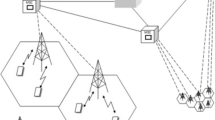Abstract
Previous studies of call admission control (CAC) in mobile communication networks focused on call blocking and call dropping mechanisms. However, achieving global optimization of the system benefit is a complicated process. In this paper, we propose a benefit optimization model that accommodates as many users as possible, while simultaneously maintaining system-wide quality of service (QoS) in terms of admission control. To clarify the CAC concept, we construct a framework of CAC policies, derive associated interference models based on the framework, and then investigate the effects of the policies on the system benefit. In addition, to solve the complicated integer programming problem, we adopt the Lagrangean relaxation approach, and employ Lagrangean multipliers to perform sensitivity analysis of several parameters. The contribution of this study is twofold: the novel problem formulation and the improvement in the system benefit. The computational results demonstrate that the system accrues more benefit as new traffic is loaded and the number of users increases. Meanwhile, the sensitivity analysis shows that proper assignment of the strength of power-controlled signals is a key factor in the global optimization of the system benefit.
Similar content being viewed by others
References
Kim, K., & Han, Y. (2000). A call admission control with thresholds for multi-rate traffic in CDMA systems. In Proc. IEEE 51st VTC (Vol. 2, pp. 830–834).
Shin, S. M., Cho, C.-H., & Sung, D. K. (1999). Interference-based channel assignment for DS-CDMA cellular systems. IEEE Transactions on Vehicular Technology, 48(1), 233–239.
Kim, K., & Han, Y. (2001). A call admission control scheme for multi-rate traffic based on total received power. IEICE Transactions on Communications, E84-B(3), 457–463.
Dahlhaus, D., & Cheng, Z. (2000). Smart antenna concepts with interference cancellation for joint demodulation in the WCDMA UTRA uplink. In Proc. IEEE ISSSTA (Vol. 1, pp. 244–248).
Hernandez, M. A., Janssen, G. J. M., & Prasad, R. (2000). Uplink performance enhancement for WCDMA systems through adaptive antenna and multi-user detection. In Proc. IEEE 51st VTC (Vol. 1, pp. 571–575).
Wibisono, G., & Darsilo, R. (2001). The effect of imperfect power control and sectorization on the capacity of CDMA system with variable spreading gain. In Proc. IEEE PACRIM (Vol. 1, pp. 31–34).
Han, J. (2007). Frequency reassignment problem in mobile communication networks. Computers and Operations Research, 34(10), 2939–2948.
Shen, J., Xu, F., & Zheng, P. (2005). A tabu search algorithm for the routing and capacity assignment problem in computer networks. Computers and Operations Research, 32(11), 2785–2800.
Aardal, K., Hurkens, C., Lenstra, J. K., & Tiourine, S. (2002). Algorithms for radio link frequency assignment: the CALMA project. Operations Research, 50(6), 968–980.
Fischetti, M., Lepschy, C., Minerva, G., Romanin-Jacur, G., & Toto, E. (2000). Frequency assignment in mobile radio systems using branch-and-cut techniques. European Journal of Operational Research, 123(2), 241–255.
Castelino, D. J., Hurley, S., & Stephens, N. M. (1996). A tabu search algorithm for frequency assignment. Annals of Operations Research, 63, 301–319.
Chu, K.-C., Hung, L.-P., & Lin, F. Y.-S. (2009). Adaptive channel reservation for call admission control to support prioritized soft handoff calls in a cellular CDMA system. Annals of Telecommunications 64(11–12), 777–791. doi:10.1007/s12243-009-0126-x. Forthcoming.
Park, K. S., & Cho, D. H. (1999). An advanced channel access scheme for integrated multimedia services with various bit rates in CDMA networks. IEEE Communications Letters, 3(4), 91–93.
Kwon, S. K., Jeon, H. G., & Lee, H. (1997). A channel assignment scheme for integrated services in DS-CDMA cellular systems. In Proc. IEEE ICUPC (Vol. 2, pp. 642–645).
Viterbi, A. M., & Viterbi, A. J. (1993). Erlang capacity of a power controlled CDMA system. IEEE Journal on Selected Areas in Communications, 11(6), 892–900.
Lee, D. M., Son, D. C., & Seong, H. S. (1997). Queuing priority channel assignment scheme for Handoff in CDMA cellular system. In Proc. IEEE ICICS ’97 (Vol. 3, pp. 1766–1770).
Chu, K.-C., & Lin, F. Y. S. (2006). Survivability and performance optimization of mobile wireless communication networks in the event of base station failure. Computers and Electrical Engineering, 32(1–3), 50–64.
Geoffrion, A. M. (1974). Lagrangean relaxation and its use in integer programming. Mathematical Programming Study, 2(1), 82–114.
Fisher, M. L. (1981). The Lagrangian relaxation method for solving integer programming problems. Management Science, 27(1), 1–18.
Held, M., Wolfe, P., & Crowder, H. D. (1974). Validation of subgradient optimization. Mathematical Programming, 6, 62–88.
Author information
Authors and Affiliations
Corresponding author
Rights and permissions
About this article
Cite this article
Chu, KC., Lin, F.YS. & Hung, LP. The effect of call admission policies on the system benefit of CDMA communication networks. Telecommun Syst 46, 285–297 (2011). https://doi.org/10.1007/s11235-010-9293-3
Published:
Issue Date:
DOI: https://doi.org/10.1007/s11235-010-9293-3




